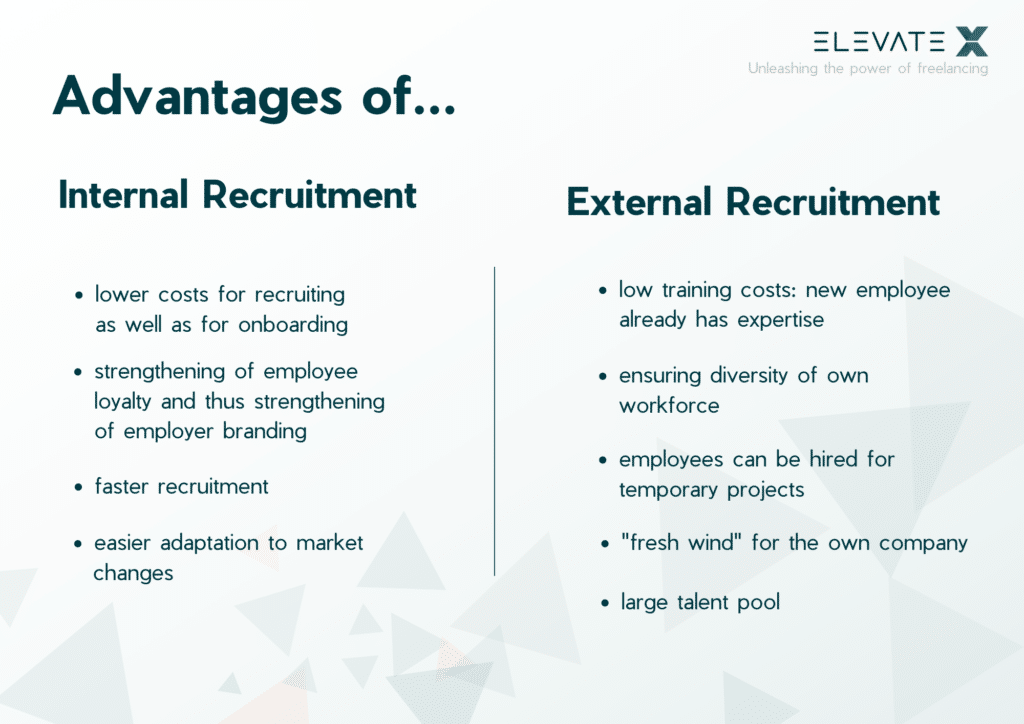The shortage of skilled workers and labor has made recruiting a critical process for success for all companies. Both internal and external recruitment serve as instruments for filling the company’s own vacancies. However, there are specific advantages and disadvantages to be considered for both options. These ensure that not all tools of both external and internal recruiting are equally suitable for every case.
Recruiting In General - What Are The Options?
In principle, internal and external recruiting are the two common options for filling vacancies. Employee referrals are also becoming increasingly important. In such a case, the impulse comes from within your own company, but you hire an external force. It is therefore a recruiting process that lies at the intersection of the two options.
There is also the possibility of hiring personnel temporarily. In the past, this form of temporary employment was particularly widespread in the area of unskilled labor. In the meantime, however, skilled workers are also being lent out more and more frequently. In addition, the company’s own ranks can be supplemented by freelancers.
In the following, we focus on internal and external recruitment. The associated recruiting methods are used to permanently fill open positions. They are therefore of particular importance.
KEY POINTS
- The most important advantage of internal recruiting is the speed of hiring. Companies can respond promptly.
- The most significant advantage of external recruitment is the integration of fresh impulses and previously missing knowledge into the company.
- In general, none of the variants is better: it always depends on the current situation.
- It is not only the choice between internal and external recruiting. It is always also the decision for the right tool or method.
Internal Recruitment
Internal recruitment as a term describes the promotion (or transfer) of an employee to fill the open position. In other words, the staffing process takes place in-house.
What Is Included In Internal Recruitment?
The methods of internal recruitment often depend on the size of the business. In smaller companies, circular emails, mentions in meetings or a notice board are sufficient. In larger companies, the intranet, the company newspaper or even the employee newsletter are used for this purpose. Informal forms of announcement are also frequently encountered. If managers have a person in mind whom they consider suitable, he or she is approached specifically.
The decision to hire an internal candidate is based on the skills needed for the open position. The common factors are:
- Expertise
- Practical skills (e.g., experience in working with specific software solutions)
- Qualifications (driver’s license, foreign language skills, etc.)
- Soft skills (communication and teamwork skills, diligence, commitment, etc.)
To make internal job postings as successful as possible, it is also important to be transparent about what exactly is required. You should not create false expectations through internal advertisement. If you try too often in vain to get a promotion internally, you will eventually give up in frustration. The person in question may well have been a valuable asset up to that point.
It is in the nature of things that there is by no means always an employee available who meets the desired requirements. Part of internal recruitment is therefore always the development of the workforce’s competencies. This means in-house education overall, personal training and development, team-building processes, and the opportunity to gain broader experience. For example, team members are given their own areas of responsibility for which they play a leading role.
The development of a company’s personnel should be as targeted as possible and requires investment. As a rule, cooperation with an external training provider is profitable, as the latter can bring in impulses from outside. These are otherwise lacking in internal recruitment.
Advantages Internal Recruitment
- lower costs for recruiting as well as for onboarding
- strengthening of employee loyalty and thus strengthening of employer branding
- faster recruitment
- easier adaptation to market changes
In summary: You can respond quickly to a need. Internal staffing often costs less than external sourcing. The employee knows the company and quickly finds his way around. You also signal to your team that there are opportunities for advancement.
Disadvantages Internal Recruitment
- The vacancy created by moving up needs to be filled.
- The talent pool has a limited size.
- Team or department morale can suffer because competitive thinking spreads.
- Cost benefits can be eaten up by having to invest in training to develop talent.
- Risk of “operational blindness” due to lack of new impetus from outside.
- It is possible that a position is not optimally filled because no suitable candidate was available internally.
- A Plan for internal recruitment is often missing: risk of process being suboptimal.
In summary: There may be a lack of suitable candidates. “Fresh wind” from the outside fails to materialize. And the workforce can develop a harmful competitive mindset.
When Should You Use Internal Recruitment?
If there is a person on your staff that you absolutely want to promote to an open position, you should do so. It would be criminal to ignore a desired candidate who is available in-house. Internal appointments otherwise make sense if you want to minimize the risk of making a wrong choice under time pressure. It is always important to keep in mind what it means for the social structure of teams or departments to make changes. This is especially true if the person continues to work among colleagues but now takes on a leadership role.

External Recruitment
External recruitment refers to the recruitment of employees from people who have not previously worked for the company. It is therefore the form of recruiting that most people think of when they hear that a company is hiring a new person.
What Is External Recruitment?
External recruiting includes job postings, using job boards, hiring recruiting service providers, posting jobs through a company’s website and social media, and getting referrals. Special events such as recruiting days or attending job fairs can also help.
In general, a distinction can be made between active and passive recruiting. Active methods include the processes mentioned above. Passive tools include collecting unsolicited applications, strengthening employer branding and building a talent pool. In simple terms, this is about having a database of external talent that you can access when you need it.
Advantages External Recruitment
- large talent pool
- low training costs: new employee already has expertise
- ensuring diversity of own workforce
- employees can be hired for temporary projects
- “fresh wind” for the own company
In summary: The talent pool is significantly larger than with internal recruitment and you provide new impulses from outside. It’s also possible to hire people for projects temporarily only, which prevents promotions from having to be rolled back for members of the core workforce.
Disadvantages External Recruitment
- more expensive than internal recruitment
- longer time to hire
- possibly negative for team morale if the manager comes from the outside
- risk of unpleasant surprises as new hires are not known and may not be a good fit
- longer onboarding
In summary: The time and financial investment is high. There is also a risk that the person hired will not fit and the process will have to start all over again.
When Should You Use External Recruitment?
External recruitment is usually unavoidable for many companies due to a lack of suitable internal candidates. It is also the right decision when a person with a specific profile is needed. Expertise in IT security is an example of know-how that often has to come from outside. External sourcing is also the right method when recommendations are made by people you trust. A mentoring system should be in place for onboarding to make this process as effective and structured as possible. If it is missing, you should definitely establish it.
Looking for a Freelancer?
Internal And External Recruitment In Direct Comparison
In a direct comparison, it is noticeable that both variants are familiar with a variety of methods. It is therefore not enough to say, for example, that you want to promote internally. It is also a matter of choosing the right tool. Moreover, not every company has the expertise to decide whether a freelancer would not be more advantageous than a permanent hire of a professional who comes from outside. It is not “only” the decision between internal and external sourcing, but always the choice of the best possible tool.
When Should I Use Which Type Of Recruitment?
The decision between internal and external recruitment is therefore the first step in the recruiting process. In this regard, setting individual priorities is crucial. If it is a matter of time, internal sourcing is conclusive. If it is a matter of special competencies or a “breath of fresh air”, a new hire from outside is usually the better choice.
Conclusion
It depends on the individual case whether internal or external recruitment is more suitable. Comprehensive planning is important as the starting point of the recruiting process. What are your own priorities in filling the position? Are there factors beyond your control (time pressure, for example), which you can´t influence? After choosing external or internal sourcing, a method review should be conducted. Should you ask for recommendations, hire a recruiting partner to do the search, or perhaps send out a circular email? Which tool promises the highest chance of success? The better the planning, the greater the likelihood of successfully finding suitable candidates.
Generally, a distinction is made between internal and external recruitment. Temporary staffing and cooperations with freelancers must also be taken into account.
The term internal recruitment describes the necessary steps for filling a vacancy with a person who is already working in the company.
The term external recruitment describes the methods for hiring a person who has not previously worked for the company.








